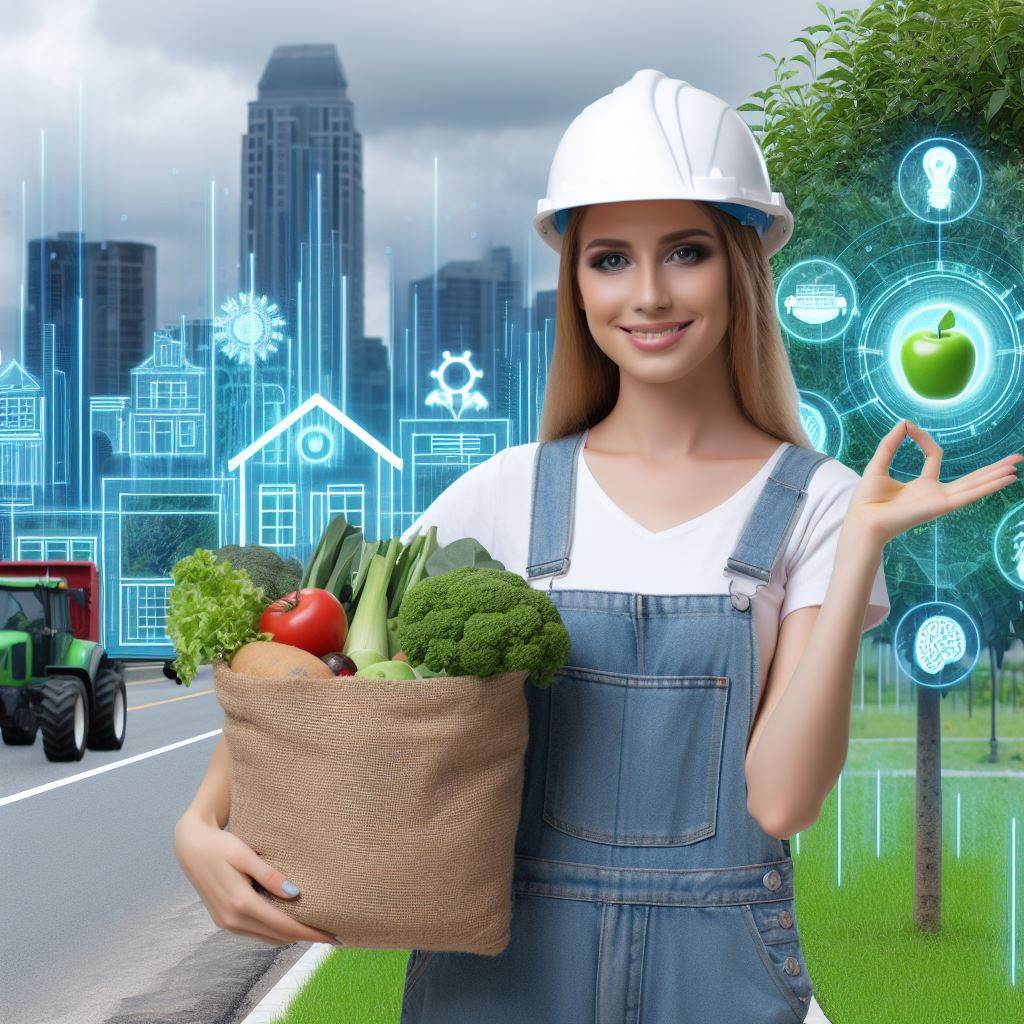Introduction
Carbon reduction is of paramount importance in the farming industry. As agriculture contributes a significant portion of greenhouse gas emissions, finding effective ways to reduce carbon footprint becomes imperative.
Implementing innovative technologies in farming practices has proven to be an effective approach towards achieving carbon reductions.
Technology has revolutionized the way we approach farming, offering promising solutions to reduce carbon emissions.
Precision agriculture tools, such as soil sensors and satellite imagery, enable farmers to optimize fertilizer application, reducing wastage and limiting greenhouse gas emissions.
Additionally, advanced irrigation systems, like drip irrigation and precision sprinklers, minimize water usage and consequently reduce the carbon footprint associated with water pumping and distribution.
Harnessing renewable energy sources is another innovative way to cut carbon emissions in the agricultural sector.
Solar panels and wind turbines can be installed on farms to generate clean electricity, reducing reliance on fossil fuels and lowering greenhouse gas emissions.
Furthermore, bioenergy systems that convert organic waste into biogas provide a dual benefit of waste management and renewable energy production, contributing to carbon reduction goals.
Integrating digital platforms and data analytics has also proven beneficial in optimizing farming operations and reducing carbon emissions.
Farm management software and data-driven decision-making enable farmers to monitor crop conditions, manage resources efficiently, and minimize inputs like water and fertilizers, thereby reducing carbon emissions.
In short, carbon reduction is paramount in farming, and technology plays a pivotal role in achieving these reductions.
By adopting innovative solutions such as precision agriculture tools, renewable energy sources, and data-driven decision-making, farmers can contribute to a more sustainable and environmentally friendly future.
Current State of Carbon Emissions in Farming
Statistics on greenhouse gas emissions from agriculture
According to the Food and Agriculture Organization (FAO), agriculture accounts for about 14% of global greenhouse gas emissions.
Livestock production, including enteric fermentation and manure management, contributes 44% of these emissions.
Rice cultivation contributes around 11%, while synthetic fertilizers contribute about 9% of total agricultural emissions.
Transform Your Agribusiness
Unlock your farm's potential with expert advice tailored to your needs. Get actionable steps that drive real results.
Get StartedDeforestation for agricultural purposes is responsible for roughly 10% of global carbon dioxide emissions.
The impact of these emissions on climate change
The greenhouse gases emitted by farming systems contribute to global warming and climate change.
Carbon dioxide emitted from burning fossil fuels used in machinery and transportation contributes significantly.
Methane, released during livestock digestion and manure management, has a much greater warming potential compared to carbon dioxide.
Nitrous oxide, released from synthetic fertilizers and manure, also has a high warming potential.
These gases trap heat in the atmosphere, leading to an imbalance in the Earth’s energy system.
As a result, global temperatures rise, causing more frequent and intense extreme weather events.
Climate change also disrupts rainfall patterns, affecting agricultural productivity and food security.
In addition to these direct impacts, agriculture is also affected by climate change.
Changing temperature and precipitation patterns can disrupt crop growth, leading to yield reductions.
Increased pests, diseases, and weed infestations further jeopardize food production.
Water scarcity, another consequence of climate change, poses challenges for irrigation and livestock management.
Overall, climate change poses a significant threat not only to food production but also to farmer livelihoods.
Given the current state of carbon emissions in farming, there is a critical need for innovative solutions to reduce these emissions.
Farmers, policymakers, and researchers are exploring various technologies and practices to mitigate greenhouse gas emissions.
Notable innovations in green farm tech
Here are some notable innovations in green farm tech:
- Precision agriculture: Using advanced sensors, drones, and GPS technology to optimize resource use, reducing emissions.
- Conservation tillage: Minimizing soil disturbance during planting, reducing carbon loss and promoting soil carbon sequestration.
- Organic farming: Eliminating synthetic fertilizers and pesticides, reducing nitrous oxide emissions and improving soil health.
- Agroforestry: Intercropping trees with agricultural crops, sequestering carbon, reducing erosion, and enhancing biodiversity.
- Methane capture: Installing anaerobic digesters to capture methane emissions from livestock manure and converting it into biogas.
- Nutrient management: Implementing precision application of fertilizers to minimize run-off, thus reducing nitrous oxide emissions.
- Cover cropping: Planting cover crops during fallow periods to improve soil health, sequester carbon, and reduce erosion.
- Renewable energy integration: Using solar panels and bioenergy systems to power farm operations, reducing reliance on fossil fuels.
These innovations demonstrate the potential for agriculture to reduce its carbon footprint and contribute to climate change mitigation.
It is crucial to promote knowledge exchange and support the adoption of these technologies at a global scale.
Investment in research and development, financial incentives, and policy support can accelerate the transition to a greener farming sector.
By embracing these innovations, farmers can improve their resilience to climate change while contributing to a sustainable future.
Read: Low-Till Farming: Saving Soil and Air
Innovations in Green Farm Technology
Introduction to various green farming technologies
Green farm technology refers to the integration of innovative practices and techniques in agriculture to minimize carbon emissions and promote sustainable farming.
Various green farming technologies have emerged in recent years to address these challenges.
Precision agriculture
Precision agriculture involves the use of advanced technologies, such as GPS and sensors, to optimize farming practices.
Showcase Your Farming Business
Publish your professional farming services profile on our blog for a one-time fee of $200 and reach a dedicated audience of farmers and agribusiness owners.
Publish Your ProfileIt allows farmers to apply the right amount of inputs, such as fertilizers and pesticides, at the right time and in the right place.
By adopting precision agriculture methods, farmers can reduce chemical inputs and improve the efficient utilization of resources.
Renewable energy solutions
In the quest for carbon-cutting initiatives, farmers are turning to renewable energy sources to power their farms.
Solar panels, wind turbines, and bioenergy systems are being implemented to replace fossil fuel-powered machinery.
By utilizing renewable energy solutions, farmers can significantly reduce greenhouse gas emissions associated with traditional farming practices.
Efficient water usage
Water scarcity is a major concern in agriculture, especially in arid regions.
Green farming technologies focus on minimizing water wastage and improving irrigation practices.
Precision irrigation systems, such as drip irrigation and soil moisture sensors, help farmers optimize water usage based on actual crop needs.
By efficiently managing water resources, farmers can minimize the energy requirements for irrigation, thus reducing carbon emissions.
Organic farming techniques
Organic farming techniques promote sustainable agricultural practices without relying on synthetic chemicals and genetically modified organisms.
Organic farmers use natural fertilizers, such as compost and manure, instead of synthetic fertilizers, reducing the usage of fossil fuel-intensive fertilizers.
Moreover, organic farming practices enhance soil health, increasing its carbon sequestration potential and mitigating climate change.
How each technology helps to reduce carbon emissions
Each green farming technology contributes to the reduction of carbon emissions in distinct ways, ultimately making agriculture more sustainable and environmentally friendly.
Precision agriculture reduces chemical inputs and improves resource utilization
Precision agriculture minimizes the use of chemicals by targeting specific areas or plants, reducing the overall quantity of fertilizers and pesticides applied.
This precision reduces the environmental impact of chemical runoff and leaching into waterways, thus mitigating carbon emissions.
It also optimizes the use of machinery and resources, reducing energy consumption and greenhouse gas emissions associated with farming activities.
Renewable energy solutions replace fossil fuel-powered machinery
Renewable energy solutions play a vital role in reducing carbon emissions in agriculture.
By replacing fossil fuel-powered machinery with renewable energy sources, such as solar or wind power, farms can effectively reduce their reliance on non-renewable energy.
This transition to cleaner energy sources decreases greenhouse gas emissions and contributes to the overall carbon reduction efforts.
Efficient water usage minimizes energy requirements for irrigation
Efficient water usage significantly impacts carbon emissions, as energy is required for water extraction, treatment, and distribution.
Green farming technologies, like precision irrigation systems, help optimize water usage by delivering the right amount of water to crops at the right time.
By reducing water wastage, farmers can also minimize the energy needed for pumping and irrigation, consequently reducing carbon emissions.
Organic farming techniques reduce synthetic fertilizer usage and promote soil health
Organic farming techniques have multiple benefits when it comes to carbon reduction.
By eliminating the use of synthetic fertilizers, organic farmers decrease energy-intensive manufacturing processes associated with their production.
Instead, they rely on natural fertilizers that are often locally sourced, further reducing transportation emissions.
Organic practices also promote soil health and increase the soil’s carbon sequestration capacity, making them an important tool in mitigating climate change.
In fact, innovations in green farm technology offer promising solutions for reducing carbon emissions in agriculture.
Precision agriculture, renewable energy solutions, efficient water usage, and organic farming techniques all contribute to sustainable agriculture practices.
By adopting these technologies, farmers can minimize their environmental impact, mitigate climate change, and ensure the long-term viability of food production.
Read: Agroforestry: Blending Crops and Carbon Care
Success Stories of Green Farm Technology Implementation
Case studies of farms that have adopted green technologies
- One farm implemented drip irrigation, reducing water usage by 50% while increasing crop yield.
- Another farm used vertical farming techniques, maximizing land use and increasing production capacity.
- A third farm incorporated precision agriculture, using sensors and GPS technology to optimize fertilizer usage.
These specific technologies have had a significant positive environmental impact.
By using drip irrigation, the first farm minimized water wastage and preserved local water resources.
The second farm’s vertical farming techniques reduced the need for large land areas, conserving natural habitats.
The third farm’s precision agriculture approach reduced fertilizer runoff, preventing water pollution.
Moreover, adopting green farm technologies has resulted in various economic benefits for the farmers.
The first farm reported a cost reduction of 30% due to water conservation and increased crop yield.
The second farm saw a significant increase in revenue as they were able to produce more crops within the same land area.
The third farm experienced improved efficiency, reducing fertilizer expenses and increasing overall profitability.
Interview or quotes from farmers about their experiences with green farm technology
Interviewing farmers who have implemented green farm technologies provides valuable insights into their experiences and outcomes.
John, a farmer who adopted drip irrigation, expressed, “I used to waste so much water with traditional irrigation methods.
Showcase Your Farming Business
Publish your professional farming services profile on our blog for a one-time fee of $200 and reach a dedicated audience of farmers and agribusiness owners.
Publish Your ProfileSwitching to drip irrigation not only saved water but also increased my crop yield by 20%.”
Sarah, a farmer who embraced vertical farming, shared her views, “Vertical farming has been a game-changer for me.
I can now grow twice the amount of crops in half the space. It has transformed my business and made it more profitable.”
Michael, who embraced precision agriculture, highlighted, “By using sensors and GPS technology, I can precisely deliver fertilizer, minimizing waste and reducing my expenses.
It has made my farming practices more sustainable and financially sound.”
These farmers’ stories emphasize the tangible benefits and positive impact of green farm technology adoption.
Not only are these technologies contributing to environmental sustainability, but they are also revolutionizing farming practices and empowering farmers to be more efficient and economically successful.
Read: Carbon-Smart Soil: The Future of Farming

Challenges and Future Outlook
The challenges faced in implementing green farm technology
Implementing green farm technology comes with its own set of challenges that need to be addressed in order to achieve widespread adoption.
Cost of technology adoption
One of the major challenges faced by farmers in implementing green farm technology is the high cost associated with adopting these innovative practices.
From purchasing eco-friendly equipment to installing renewable energy systems, the initial investment can often be a barrier for farmers, especially those with limited financial resources.
Lack of awareness or knowledge among farmers
Another obstacle in implementing green farm technology is the lack of awareness or knowledge among farmers.
Many farmers may not be aware of the potential benefits of adopting sustainable practices or may not have the necessary information on how to implement them effectively.
This highlights the need for educational programs and outreach efforts to disseminate information about green farm technologies and their advantages.
Potential resistance to change
Resistance to change is a common challenge faced when introducing new technologies in any industry, including agriculture.
Some farmers may be hesitant to adopt green farm technology due to concerns about disrupting their traditional farming practices or fear of potential risks.
Overcoming this resistance requires effective communication, showcasing success stories, and providing support to farmers during the transition period.
Potential solutions to overcome these challenges
To overcome the challenges faced in implementing green farm technology, several potential solutions can be explored:
Government support and incentives
Governments can play a crucial role in promoting green farm technology adoption by offering financial support and incentives to farmers.
This can include subsidies for purchasing eco-friendly equipment, grants for implementing renewable energy systems, or tax benefits for adopting sustainable farming practices.
Such support can significantly reduce the cost barrier and encourage farmers to adopt green technologies.
Education and training programs for farmers
Providing comprehensive education and training programs for farmers is essential to increase awareness and knowledge about green farm technology.
These programs can be designed to cover the benefits of sustainable practices, technical know-how of implementing new technologies, and best practices for maximizing efficiency.
By equipping farmers with the necessary skills and knowledge, they will be better prepared to adopt and implement green technologies.
Collaboration between farmers and technology providers
Foster collaboration between farmers and technology providers can help address the challenges associated with implementing green farm technology.
By involving farmers in the research and development of sustainable practices and technologies, their concerns and needs can be better understood.
This collaboration can lead to the development of tailored solutions that are more effective and suitable for the agricultural sector.
The future potential of green farm technology in carbon reduction
The potential of green farm technology in carbon reduction is immense and holds promise for a sustainable future:
Green farm technology offers the opportunity to significantly reduce greenhouse gas emissions in the agricultural sector.
By implementing sustainable practices and adopting eco-friendly technologies, farmers can minimize their carbon footprint and contribute to a greener environment.
From utilizing renewable energy sources, optimizing water management, reducing chemical inputs, to implementing precision agriculture techniques, every aspect of farming can be transformed to reduce carbon emissions.
Additionally, the future potential of green farm technology lies in innovations that are continuously being developed.
Advancements in artificial intelligence, robotics, and remote sensing technologies are revolutionizing farming operations, making them more efficient and environmentally friendly.
From autonomous farm equipment to precision farming systems, these innovations have the potential to further enhance carbon reduction efforts in the agricultural industry.
In a nutshell, while implementing green farm technology presents its own share of challenges, solutions are available to overcome them.
With government support, educational programs, and collaborations between farmers and technology providers, the adoption of sustainable practices can be promoted.
The future potential of green farm technology in carbon reduction is promising, with continuous innovations driving towards a more sustainable and environmentally friendly agricultural sector.
Read: Eco-Farming: Key to Lower Carbon Emissions
Conclusion
Throughout this blog section, we have highlighted the crucial significance of carbon reduction in farming.
By minimizing carbon emissions, we can mitigate climate change and its detrimental effects on agriculture.
Showcase Your Farming Business
Publish your professional farming services profile on our blog for a one-time fee of $200 and reach a dedicated audience of farmers and agribusiness owners.
Publish Your ProfileGreen farm technology plays a pivotal role in achieving carbon reductions.
Innovations such as precision agriculture, renewable energy integration, and sustainable farming practices can significantly decrease carbon footprints in the agricultural sector.
It is imperative for farmers to embrace and leverage these technological advancements.
By implementing green farm technologies, farmers can enhance productivity while preserving the environment for future generations.
Let us join hands to build a sustainable and resilient agriculture sector.




